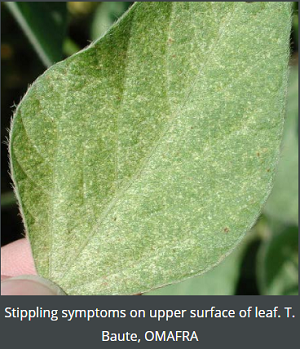Reports have already come in of a few soybean fields that have reached threshold and need to be sprayed this week for spider mites. This hot, dry weather at the start of wheat harvest is the perfect scenario for significant spider mite infestations to move into soybeans, dry beans and possibly even the corn crop.
Spider mites are currently on grass plants including wheat and ditch bank grasses. As these plants dry down for harvest or get cut, mites move to other hosts. Infestations tend to start on the fields edge but with enough windy days, they can get carried deeper into fields.
Scout field edges first. Look for plants that are yellow or bronze in colour, look drought stressed or sand blasted. Signs of stippling (white or yellow dots) on the upper surface of the leaf are caused by mites feeding and collapsing individual plant cells in the leaf. Turn the leaf over and look for webbing or what appears to be dust on the leaf. Watch for tiny moving dots. A hand lens is best to see the actual mites and also to look for their eggs which are tiny, clear spheres stuck to the leaf. Check random areas within the field and look again for signs of bronzing plants that look off from the rest of the field.

Action Threshold for beans and soybeans: 4 mites per leaflet or 1 severely infested plant. Rain can help knock populations down, especially if the welcome moisture promotes mite killing fungus to kick into gear. So re-scout after a rain event before making a decision about spraying. If the infestation is limited to the field’s edge and at threshold, a perimeter spray might be all that is needed.
Dimethoate (Cygon/Lagon) is the only product registered for spider mites on soybeans and edible beans. DO NOT use Matador, it does not control spider mite and will kill beneficial insects which include ladybird beetle, thrips, and predaceous mites. To protect pollinators, spray at night when bees are less likely to be foraging. With temperatures remaining warm in the evenings, bees could still be actively foraging until dark. Contact local beekeepers within 5 km of the field so they can take precautions to protect their hives.
Re-scout the field after an application has been made. If there were a lot of eggs on the plants, there could be a new generation start up, since dimethoate only controls adults and nymphs.
Source : Field Crop News